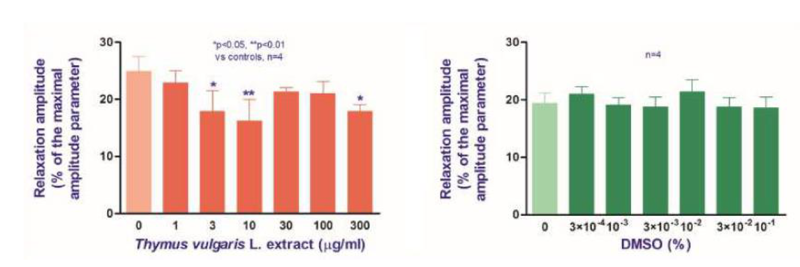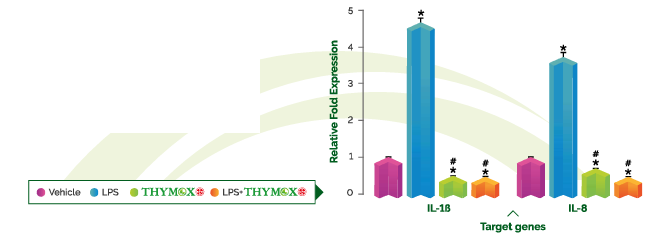Knowde Enhanced TDS
Identification & Functionality
- Active Component
- Ingredient Name
- Ingredient Origin
- Ingredients
- Thyme Extract
- Product Families
- Botanical Information
Thymus vulgaris L. is commonly known as thyme (synonyms: Common Thyme, Garden Thyme) and belongs to the Lamiaceae family; it is an evergreen dwarf shrub, indigenous to the Mediterranean area, Northern Africa and some parts of Asia (1); its habitats consist in dry slopes, rocks and maquis, where it can be found on sandy or loamy soils (2); nowadays it is extensively cultivated all over the world (1,3).
The plant can grow up to 50 cm high (1); it has bushy aspect, with erect, woody stems. The tiny, gray-green leaves are short petioled, linear or elliptic; they have a characteristic aromatic, odor (1), resembling that of thymol (4). The lilac, pink, tubular, labiate flowers are arranged in axillary clusters; they appear during summer (from June to August) (2). The fruit is made of four brown ovoid nutlets.
- Active Constituents
The main components of thyme leaf are volatile oils (min. 1,2%) containing as chief components thymol, p-cymene and carvacrol; caffeic acid derivatives (rosmarinic acid); flavonoids (luteolin, apigenin etc.), triterpenes (ursolic acid, oleanolic acid)
- Galenic Forms
THYMOX-EPO® is a dry powdered extract, manufactured by hydroalcoholic extraction (general method according to EP X) and standardized to contain 0,3% total phenols, calculated as thymol (spectrophotometric method, DAB 10).
Features & Benefits
- Labeling Claims
- Food Ingredients Features
- Product Highlight
Thyme is a well-known Mediterranean plant, belonging to the Lamiaceae family. Thyme has been traditionally used since ancient times as a natural remedy for cough and for many other purposes, as digestive, spasmolytic, carminative and antioxidant. The actives are mainly concentrated in the aerial parts, collected at blooming time Thyme contains essential oils (as thymol), tannins, flavonoids and triterpenes.
Thymox-EPO is a dry powdered extract, obtained from Thymus vulgaris L aerial parts by hydro-alcoholic extraction. Thymox-EPO is standardized to contain 0.30% thymol. The botanical species is certifed by DNA barcoding analysis. The efficacy of Thymox-EPO is based on pre-clinical evidence. proving its double effect as an anti-inflammatory and expectorant agent: that makes Thymox-EPO suitable for respiratory tract inflammations, asthma, dry and productive cough.
Applications & Uses
- Markets
- Food & Nutrition Applications
- Physiologic and Healthcare Applications
- Expectorant (used in productive cough associated with cold, and bronchitis).
- Digestive.
- Spasmolytic, carminative.
- Antioxidant.
- Balsamic.
- Antiseptic for the throat and the respiratory system.
- Flavoring agent.
- Topical use: skin protecting.
- Parts Used
Dried Leaves, Collected At Blooming Time.
- Traditional Uses
Thyme has a very long history of folk use in the Mediterranean area and it was mentioned by Greek and Roman classical writers such as Dioscorides, Hippocrates, Pliny, Virgil. The antibacterial action of Thyme essential oil was demonstrated by Chamberland in 1887 on a carbuncle infection. Its efficacy was later experimented in France on other infectious agents, such as those causing typhus and distemper (5-7). Apart from its antiseptic and antioxidant properties, thyme is an excellent tonic and it used in treating respiratory diseases and a variety of other ailments (3) and has a strong anti-inflammatory activity. Thyme is also spasmolytic, vermifuge and expectorant (1,3); it is used internally for catarrh of the upper respiratory tract, dyspeptic complaints, asthma, laryngitis, chronic gastritis, and whooping cough (1). The German Commission E has approved the use of thyme for cough, bronchitis and whooping cough (6). Externally it is used as a mouthwash and gargle for inflammations of the mouth and throat, tonsillitis, pruritus, dermatoses, and poorly healing wounds (1). Moreover, the commercial extract THYMOX-EPO® showed strong anti-inflammatory and expectorant properties (8-9). Thyme preparations are traditionally used in some countries for the relief of digestive disorders and in particular for dyspepsia (1). This term refers to a heterogeneous group of symptoms that are localized in the epigastric region. Typical dyspeptic symptoms include postprandial fullness, early satiation, epigastric pain and burning, but other upper gastrointestinal symptoms such as nausea, belching or abdominal bloating often occur. Functional dyspepsia may be attributed to a disturbance of some gastric physiologic factors, such as slow gastric emptying, failure of the gastric fundus to relax after a meal (fundic disaccommodation, which is a vagal reflex), or gastric hypersensitivity with distention of the stomach (10- 11). Therefore, for this kind of discomfort, gastric fundus relaxants have shown symptomatic benefits in dyspeptic subjects. To investigate the role of THYMOX- EPO® on dyspeptic symptoms, the extract was tested by the Catholic University of the Sacred Heart in Rome in an in vitro model of the gastric accomodation, i.e. the non adrenergic noncholinergic (NANC) relaxation of the rat proximal stomach (12).The treatment with THYMOX-EPO® significantly influences the NANC relaxation of the proximal stomach induced by low-frequency neuronal activation (Fig. 1), mainly by inhibiting the nitric oxide-mediated component (Fig. 2). Therefore, it relaxes the smooth muscle of the proximal stomach (gastric fundus). These results suggest that this action could be responsible for THYMOX-EPO® beneficial digestive effects (12).

Figure 1. THYMOX-EPO® extract significantly reduces the peak amplitude of 2Hz
EFS(Electric Field Stimulation)-induced NANC relaxation (12).
Figure 2. THYMOX-EPO® extract significantly reduces the nitrergic component of
2Hz EFS-induced NANC relaxation (12).
Properties
- Odor
- Characteristic
- Typical Properties
- Microbiological Values
- Nutritional Information
- Heavy Metals
| Value | Units | Test Method / Conditions | |
| Particle Size (through 300 microns) | min. 90 | % | — |
| Bulk Density | 350 - 700 | g/L | — |
| Eucalyptol | max. 0.005 | % | — |
| Carvacrol | 0.1 | % | — |
| Camphre | max. 5 | ppm | — |
| Loss on Drying | max. 5 | %w/w | — |
| pH | 4 - 6 | — | — |
| Heavy Metals | max. 20 | ppm | (method C Ph. Eur. current edition) |
| Aflatoxin B1 | max. 2 | ppb | — |
| Aflatoxin B1,B2,G1,G2 | max. 4 | ppb | — |
| Benzo(a)pyrene | max. 10 | ppb | — |
| Sum of Benzo(a)pyrene, benzo(a)anthracene, benzo(b)fluoranthene and chrysene | max. 50 | ppb | — |
| Pyrrolizidine Alkaloids | max. 400 | ppb | — |
| Bile-tolerant gram-negative bacteria | max. 100 | ufc/g | — |
| Value | Units | Test Method / Conditions | |
| Bacterial Count | max. 50000 | ufc/g | (TAMC: ref. 5.1.8, cat. B oral use): |
| Yeasts and Moulds Count | max. 500 | ufc/g | (TYMC: ref. 5.1.8, cat. B oral use): |
| Salmonella | Absent in 25g | — | — |
| Escherichia coli | Absent in 1g | — | — |
| Value | Units | Test Method / Conditions | |
| Carbohydrates | 90 - 95 | % | — |
| Fat Content | 0 - 1 | % | — |
| Protein Content | 0 - 1 | % | — |
| Energy Value | 409 | Kcal/100 gr | — |
| Value | Units | Test Method / Conditions | |
| Minerals | 3 - 5 | % | — |
| Lead Content | max. 3 | ppm | (ref. Reg. (EC) 1881/2006) |
| Cadmium Content | max. 1 | ppm | (ref. Reg. (EC) 1881/2006) |
| Mercury Content | max. 0.1 | ppm | (ref. Reg. (EC) 1881/2006) |
Regulatory & Compliance
- Certifications & Compliance
- Certifications
- DNA CERTIFIED RAW MATERIAL
- GMO: Free from GMO (Reg. (EC) 1829/2003 and 1830/2003) BSE/TSE FREE - GLUTEN FREE
- ALLERGENS: Free from substances or products causing allergies or intolerances (Reg. (EU) 1169/2011 Annex II)
Technical Details & Test Data
- Anti-Inflammatory and Expectorant Activity
Anti-inflammatory Activity
THYMOX was able to reduce the inflammation induced by LPs (Lipopolysaccharide) treatment on human respiratory epithelial cells (Oliviero et al, 2016).


- THYMOX® Shows Anti-inflammatory Effects by Decreasing
- Pro-inflammatory mediator proteins as NF-kB p65 and NF-kB p52
- Pro-inflammatory cytokines IL-18 and IL-8, at both mRNA and protein levels.
Expectorant Activity
The respiratory tract has epithelial cells characterized by cilia on the surface
The expectoration consists in the movement of mucus through the respiratory tract thanks to an efficient beating of the cilia, a Ca-mediated mechanism.
- Increases extracellular CAMP level.
- Increases Ca influx & decreases extracellular- Ca Level
- Increases ciliary beating frequency

Thymox-EPO helps the mucus clearance by increasing the frequency of beating and therefore acting on the efficiency of cilia movements
Storage & Handling
- Shelf Life
- 3 Years
- Storage
Store in a well closed container away from moisture and direct sun light

